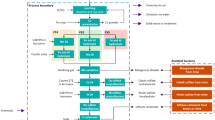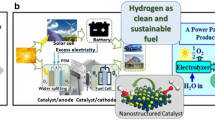Abstract
Derivation of a mathematical model for microbial fuel cells (MFC) with suspended biomass and added electron-transfer mediator is described. The model is based on mass balances for several dissolved chemical species such as substrate, oxidized mediator and reduced mediator. Biological, chemical and electrochemical reactions can occur in the bulk liquid and at the electrode surface, respectively. Model outputs include time-dependent production of current and electrical charge, current–voltage and current–power curves, and the evolution of concentrations of chemical species. The model behaviour is illustrated using a test case based on detailed experimental observations reported in the literature for a microbial fuel cell operated in batch mode and repeatedly fed with a single substrate. A detailed model parameter estimation procedure is presented. The model simulates the current–time evolution and voltage–current curves in the MFC with glucose as anode substrate and the ferrocyanide/ferricyanide redox couple as the oxidation reaction at the cathode. Simulations show the effect of different parameters (electrical resistance, mass transfer resistance, exchange current, coulombic yields and biomass, substrate and mediator concentrations) on the MFC characteristics. The model explains how the endogenous metabolism or intracellular substrate storage could lead to a non-zero background current even when the added substrate has been depleted. Different trends (increasing or decreasing) in the initial current are explained by the initial oxidation state of the mediator (oxidized or reduced, respectively). The model has potential applications for other bioelectrochemical systems.







Similar content being viewed by others
References
Bennetto HP, Dew ME, Stirling JL, Tanaka K (1981) Rates of reduction of phenothiazine ‘redox’ dyes by E. coli. Chem Ind 7:776–778
Beun JJ, Van Loosdrecht MCM, Heijnen JJ (2001) N-removal in a granular sludge sequencing batch airlift reactor. Biotechnol Bioeng 75(1):82–92
Bullen RA, Arnot TC, Lakemanc JB, Walsh FC (2005) Biofuel cells and their development. Biosens Bioelectron 21(11):2015–2045
Chang IS, Moon H, Bretschger O, Jang JK, Park HI, Nealson KH, Kim BH (2006) Electrochemically active bacteria (EAB) and mediator-less microbial fuel cells. J Microbiol Biotechnol 16(2):163–177
Delaney GM, Bennetto HP, Mason JR, Roller SD, Stirling JL, Thurston CF (1984) Electron-transfer coupling in microbial fuel cell. 2. Performance of fuel cells containing selected microorganisms-mediator-substrate combination. J Chem Technol Biotechnol 34B:13–27
Fuel cell handbook (2004) 7th edn. E.G&G Technical Services, Parsons, Inc. for the National Energy Technology Laboratory, www.netl.doe.gov/seca/pubs/FCHandbook7.pdf
Heijnen JJ (1999) Bioenergetics of microbial growth. In: Flickinger MC, Drew SW (eds) Encyclopedia of bioprocess technology: fermentation, biocatalysis, bioseparation. Wiley-Interscience, New York, pp 267–291
Henze, M., Gujer, W., Mino, T. and Van Loosdrecht, M.C.M. (2000) Activated sludge models ASM1, ASM2, ASM2d and ASM3. IWA Scientific & Technical Report, IWA Publishing, London, UK
Kato-Marcus A, Torres CI, Rittmann BE (2007) Conduction-based modeling of the biofilm anode of a microbial fuel cell. Biotechnol Bioeng 98:1171–1182
Katz E, Shipway AN, Wilner I (2003) Biochemical fuel cells. In: Vielstich W, Lamm A, Gasteiger HA (eds) Handook of fuel cells-fundamentals, technology, application. Wiley, Chichester, pp 355–381
Kim N, Choi Y, Jung S, Kim S (2000) Effect of initial carbon sources on the performance of microbial fuel cells containing Proteus vulgaris. Biotechnol Bioeng 70:109–114
Logan BE, Hamelers B, Rozendal R, Schröder U, Keller J, Freguia S, Aelterman P, Verstraete W, Rabaey K (2006) Microbial fuel cells: methodology and technology. Environ Sci Technol 40(17):5181–5192
Lovley DR (2006) Bug juice: harvesting electricity with microorganisms. Nat Rev Microbiol 4:497–508
Newman JS (1991) Electrochemical systems, 2nd edn. Prentice Hall, Englewood Cliffs, NJ
Picioreanu C, Head IM, Katuri KP, Van Loosdrecht MCM, Scott K (2007) A computational model for biofilm-based microbial fuel cells. Water Res 41(13):2921–2940
Picioreanu C, Katuri KP, Head IM, Van Loosdrecht MCM, Scott K (2008) Mathematical model for microbial fuel cells with anodic biofilms and anaerobic digestion. Water Sci Technol 57(7):965–971
Picioreanu C, Van Loosdrecht MCM, Curtis TP, Scott K (2009) Model based evaluation of the effect of pH and electrode geometry on microbial fuel cell performance. Bioelectrochemistry (in press). doi:10.1016/j.bioelechem.2009.04.009
Press WH, Teukolsky SA, Vetterling WT, Flannery BP (1997) Numerical recipes in C: the art of scientific computing. Cambridge University Press, NY
Rabaey K, Lissens G, Verstraete W (2005) Microbial fuel cells: performances and perspectives. In: Lens PN, Westermann P, Haberbauer M, Moreno A (eds) Biofuels for fuel cells: biomass fermentation towards usage in fuel cells. IWA Publishing, London
Rabaey K, Verstraete W (2005) Microbial fuel cells: novel biotechnology for energy generation. Trends Biotechnol 6:291–298
Roller SD, Bennetto HP, Delaney GM, Mason JR, Stirling JL, Thurston CF (1984) Electron-transfer coupling in microbial fuelcells. 1. Comparison of redox-mediator reduction rates and respiratory rates of bacteria. J Chem Technol Biotechnol B Biotechnol 34:3–12
Sakai S, Yagishita T (2007) Microbial production of hydrogen and ethanol from glycerol-containing wastes discharged from a biodiesel fuel production plant in a bioelectrochemical reactor with thionine. Biotechnol Bioeng 98:340–348
Shukla AK, Suresh P, Berchmans S, Rahjendran A (2004) Biological fuel cells and their applications. Curr Sci 87:455–468
Thurston CF, Bennetto HP, Delaney GM, Mason JR, Roller SD, Stirling JL (1985) Glucose metabolism in a microbial fuel cell. Stoichiometry of product formation in a thionine-mediated Proteus vulgaris fuel cell and its relation to coulombic yields. J Gen Microbiol 131:1393–1401
Wanner O, Eberl HJ, Morgenroth E, Noguera DR, Picioreanu C, Rittmann BE, Van Loosdrecht MCM (2006) Mathematical modeling of biofilms. IWA Scientific and Technical Report no. 18, IWA Publishing, UK
Zhang X-C, Halme A (1995) Modeling of a microbial fuel cell process. Biotechnol Lett 17:809–814
Acknowledgements
This research was supported by the European Union through Marie Curie Transfer of Knowledge fellowships to Cristian Picioreanu and Krishna Katuri (contract MTKD-CT-2004-517215).
Author information
Authors and Affiliations
Corresponding author
Rights and permissions
About this article
Cite this article
Picioreanu, C., Katuri, K.P., van Loosdrecht, M.C.M. et al. Modelling microbial fuel cells with suspended cells and added electron transfer mediator. J Appl Electrochem 40, 151–162 (2010). https://doi.org/10.1007/s10800-009-9991-2
Received:
Accepted:
Published:
Issue Date:
DOI: https://doi.org/10.1007/s10800-009-9991-2




